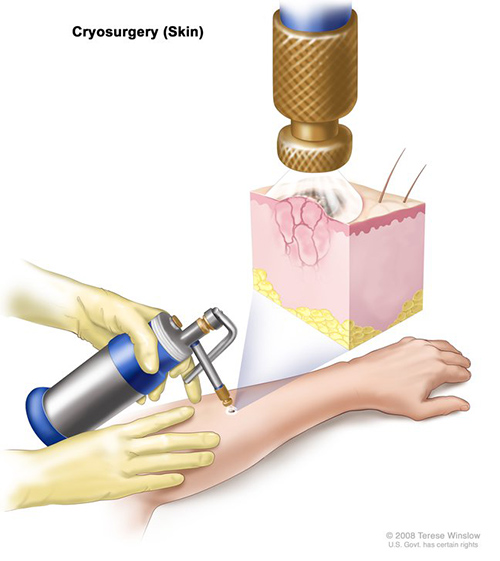Cryosurgery
Another surgical technique to remove cancer is cryosurgery, also called cryoablation and cryotherapy. Liquid nitrogen, compressed argon gas, or liquid nitrous oxide cools the probe that is used to freeze and kill the cancer cells. Cryosurgery was initially used only to treat external tumors, but the technique can now be employed as treatment for internal tumors as well.
Similar to laser surgery, cryosurgery incurs minimal blood loss, little discomfort, and shorter recovery time and shorter hospital stays. While researchers are still studying the effectiveness of cryosurgery as a treatment for other types of cancer, the technique has been used successfully in treating prostate cancer. Just as with the laser techniques, cryosurgery has proven to be effective in preventive surgeries. For example, pre-cancerous skin growths known as actinic keratosis and cervical intraepithelial neoplasia can be treated successfully with cryosurgery.
According to cancer specialists, the stage of the cancer plays an important role in opting for cryosurgery as a cancer surgical tool. Cryosurgery is most effective for younger patients whose disease is contained entirely within the prostate.
For external tumors, liquid nitrogen (-196 degrees Celsius, -320.8 degrees Fahrenheit) is applied directly to the cancer cells or tissue with a cotton swab or spraying device. For internal tumors, liquid nitrogen is circulated through an instrument called a cryoprobe, which is placed in contact with the tumor. To guide the cryoprobe and to monitor the freezing of the cells, the physician uses ultrasound (computerized moving pictures of the body generated by high-frequency sound waves). By using ultrasound, physicians hope to spare nearby healthy tissue.
Cryosurgery often involves a cycle of treatments in which the tumor is frozen, allowed to thaw, and then refrozen. The diagram below depicts cryosurgery.

Cryosurgery. An instrument with a nozzle is used to spray liquid nitrogen or liquid carbon dioxide to freeze and destroy abnormal tissue. Source: Terese Winslow (Illustrator), National Cancer Institute.
Advantages of Cryosurgery
- Minimally invasive--no blood loss, no surgical incision, and can be done as an outpatient
- Favorable success rates and less complications--less complications than open surgery
- Short recuperation period
- Procedure can be repeated if the first cryosurgery has failed
- Radiation therapy or radical surgery is still an option if the cryosurgery fails
- Cost is less than traditional treatment
A cancer registrar should record each cancer directed surgical procedure in the cancer abstract.
Updated: December 21, 2023
Suggested Citation
SEER Training Modules: Cryosurgery. U.S. National Institutes of Health, National Cancer Institute. Cited 05 January 2026. Available from: https://training.seer.cancer.gov.




